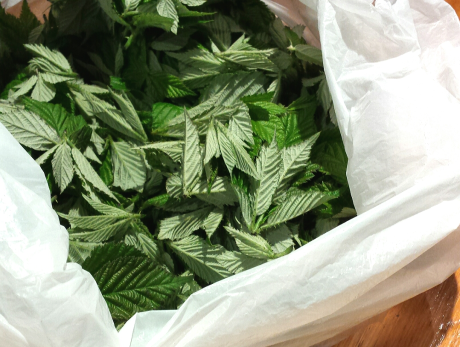How to Make Blackberry Leaf Tea
By Susan Hutchinson, Blend Your Own Herbal Teas workshop facilitator
Start by picking the blackberry shoots. You want young, tender leaves that will be bright green. You can take the stalks too, if they are bright and tender enough.
Gently wash them under the tap.
Bruise all the leaves. Last year I used a rolling pin; it was great fun. You may want to use a meat mallet, or whatever you have lying around. This year, I passed the shoots through my pasta machine, which did a superb job.
Tightly pack the bruised shoots into a sterilised glass jar. Close the lid
Leave the leaves to ferment for at least two weeks. You can just forget about them. I’m told the best place to leave them is on the dash board of the car. Being that I don’t drive, I don’t leave them in a car. I just leave them in the kitchen. The leaves will turn black and the fragrance will change from the smell of cut grass, to something more fruity and floral.
When you think they’ve fermented long enough, take them out of the jar, pull the leaves apart and dry them out. I do mine in the dehydrator, but you could lay them on a wire rack or put them in a paper or calico bag in a closet to dry.
Chop or crush up the larger pieces and transfer to a tea caddy for storage.
I use about the same volume of blackberry leaf tea as I would black tea, to make a cup. I do not add milk or sugar.
“When I first started foraging, I was on the look out for all sorts of things I could do with the goodies I picked. I was staying with my grandparents in Tasmania, and was tending Pop’s berry patch. He had strawberries and raspberries. Having heard about raspberry leaf tea, it got me wondering about blackberry leaf tea. I did some googling and found people who made fresh blackberry leaf tea, but it didn’t sound too exciting to me. It was only when I discovered you could ferment the leaves, in the same process used for black tea, that I thought we’d be talking about some flavours that were worth delving into. I had, in fact, heard it was the herbal tea which most tasted like black tea.
Last year, I fermented my blackberry leaves for two weeks and found the resulting tea tasted much like Oolong. It is very pleasant indeed. This year, I’ve fermented the leaves for much longer, wondering if the tea will have a deeper flavour. It does indeed. After up to six weeks fermenting, it has more developed tannins and is much more like black tea. Making the blackberry leaf tea is a very simple process. I like to pick and prepare enough to last me the year. The best time to go foraging for blackberry shoots is in spring, before the berries have started to form. There will be many young shoots on the plants at this time of year, and they will be tender enough, that you may not even need gloves to break them off. You can however, find young shoots on the plants year ’round.”
About Susan
Susan Hutchinson has been running workshops for the Environment Centre for over ten years. She is an avid forager and lifelong environmentalist. Her food blog, Susan's Sumptuous Suppers is packed with original recipes and tips utilising local and foraged ingredients and has featured in The Canberra Times on several occasions.
Susan was an early volunteer and member of the design team at the Lyneham Commons and now has a food forest in her small backyard in Watson. She maintains a passion for disability accessible permaculture and sustainable garden design. She forages, creates, blends and preserves wild, windfall and homegrown harvest with the seasons each year while managing a chronic disabling illness as best she can. Susan is also a part time PhD student at the Australian National University and social justice advocate
Website | Instagram
Join Susan’s Herbal Tea Workshop on 22 Oct

